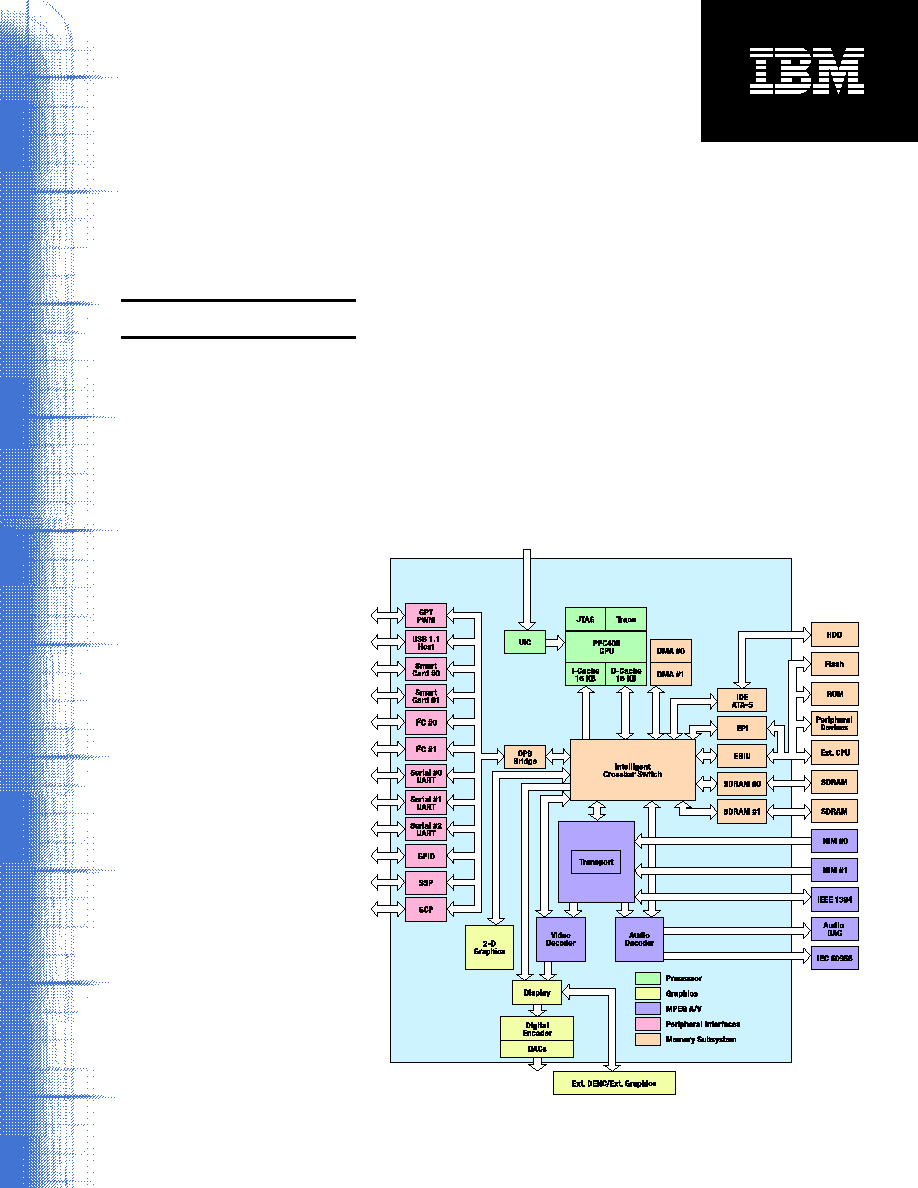 | –≠–ª–µ–∫—Ç—Ä–æ–Ω–Ω—ã–π –∫–æ–º–ø–æ–Ω–µ–Ω—Ç: STB043 | –°–∫–∞—á–∞—Ç—å:  PDF PDF  ZIP ZIP |

Robust functionality for advanced
STB applications, including Personal TV
STB04xxx and STBx5xxx Digital Set-Top Box
Integrated Controllers
Support high-performance
applications through an inte-
grated PowerPC
Æ
processor with
up to 350 DMIPS and an interface
for an optional co-processor
Enable multiple-stream and hard
disk drive (HDD)-based personal
video recorder (PVR) solutions
Provide advanced 2-D graphics
for fast, rich graphical user
interfaces
Support advanced Personal TV
and conditional access
applications from NDS
Feature optimization for
advanced software applications,
middleware, and operating
systems
Highlights
High integration and more DMIPS deliver
leading-edge capabilities
IBM STB04xxx and STBx5xxx Digital
Set-Top Box Integrated Controllers
provide manufacturers and service
providers with high-performance,
highly integrated semiconductors for
demanding set-top box (STB) applica-
tions, including PVR, VideoGuard
Æ
and
XTVTM from NDS, interactive TV, Web
browsing, and data broadcasting. The
newest members of the IBM family of
STB products, these advanced con-
trollers incorporate the IBM STB
architecture, advanced 0.15-micron pro-
cess technology, and design flexibility.
These controllers deliver high DMIPS
performance and robust functionality
geared to today's diverse and increas-
ingly large bandwidth requirements.
STBO4xxx/
STBx5xxx
External
Internal
Interrupts
Figure 1: STB04xxx and STBx5xxx Digital Set-Top Box Integrated Controllers block diagram.

performance, the controllers integrate
a glueless integrated external
processor interface that enables dual-
processor solutions.
To support NDS conditional access
(VideoGuard) and XTV applications,
IBM offers controllers that comply with
these NDS services (STB15xxx).
Additionally, customers can select a
controller with Macrovision copy pro-
tection support, Dolby
Æ
Digital audio
support, or both. A broad spectrum of
peripheral interfaces and support for
a range of industry-standard memory
further extend design flexibility.
PowerPC 405 delivers high performance
The PowerPC 405 processor, the heart
of the processor subsystem, features
high-speed operation at 126 MHz or
252 MHz, 16-KB instruction cache, and
16-KB data cache to maximize appli-
cation performance. With this process-
ing capability, STB manufacturers can
design products to support:
∑
PVR
∑
Internet gaming
∑
Interactive TV
∑
Web browsing
∑
E-commerce applications
∑
Personal TV services (NDS XTV)
Advanced digital audio and video features
support next-generation and multi-stream
applications
The digital audio and video subsystem
delivers high-quality video and sound,
enabling state-of-the-art features for
consumer applications. An advanced
MPEG-2 transport demultiplexer func-
tion, including three demultiplexers
and multistreaming capabilities, sup-
ports simultaneous dual-stream
recording and single-stream playback.
Capabilities include playing a video
stream from an HDD, live streaming
of video, and variable video scaling.
In STB15xxx controllers, the transport
function also supports NDS conditional
access and XTV Services. The digital
audio and video subsystem operates
with minimal processor intervention,
making more DMIPS available for cus-
tom application functions.
The STB04xxx and STBx5xxx
digital audio and video subsystem
incorporates:
∑
MPEG-2 video decoder; decodes
MPEG-2 Main Profile at Main Level
(MP@ML) video
∑
Three MPEG-2 transport
demultiplexers/DVB descramblers
(DES encode and decode in
STB05xxx and STB15xxx controllers)
∑
Digital encoders, including NTSC,
PAL, and SECAM analog conversion,
and six concurrent analog video
outputs
∑
MPEG-2 audio decoder; decodes
MPEG-2 Layer I & Layer II
∑
MPEG-2 Layer III (MP3) audio
decoder
∑
Dolby Digital-compliant decoding*
(STB04x1x and STBx5x1x
controllers only; Dolby Digital
license is required)
∑
Macrovision copy protection support
(STB04xx1 and STBx5xx1 controllers
only; a Macrovision license is
required)
∑
Support for NDS VideoGuard and
NDS XTV (STB15xxx controllers only;
an NDS license is required)
High performance and support for
multiple transport inputs and memory
streaming enable solutions such as
dual tuners and HDD applications.
The solution is designed to enable
middleware environments, such as
MediaHighway, which facilitate STB
services, including live broadcasts and
storing and receiving video and audio.
The IBM PowerPC ArchitectureTM pro-
vides a clear software migration path to
high-performance processors for more
demanding applications. In addition,
IBM's enabling tools can help STB man-
ufacturers improve their time-to-market.
The STB04xxx and STBx5xxx design
allows base audio and video decoding
activities to execute with minimal
host processing, thereby making more
DMIPS available to enable high-end
functions performed concurrently with
audio/video programming and enter-
tainment.
STB04xxx and STBx5xxx controllers
include five subsystems: processor,
memory, digital audio/video, 2-D
graphics, and peripheral interface.
Third-generation single-chip devices,
STB04xxx and STBx5xxx controllers
demonstrate IBM's commitment to
satisfying emerging STB requirements
through a range of advanced features.
Design flexibility supports diverse
applications
STB04xxx and STBx5xxx controllers
can offer the flexibility to satisfy
manufacturers' individual application
requirements. STB manufacturers can
choose from controllers featuring either
a 175-DMIPS or a 350-DMIPS
embedded PowerPC 405. For
applications requiring even more

Figure 2: STB04xxx and STBx5xxx controllers integrate advanced
features to satisfy emerging high-end applications
.
Graphics subsystem enables full 2-D
capabilities
The 2-D graphics subsystem incorpo-
rates a 2-D bitBLT engine supporting
up to 32 bits per pixel, graphic scaler,
command list controller, and display
engine to enable creation of brilliant
graphics and animation. This capability
allows service providers to offer graphi-
cally rich user interfaces for next-gen-
eration interactive applications.
The graphic scaler can perform
independent horizontal and vertical
scaling, using arbitrary scaling factors,
to provide zooming capabilities. The
command list controller executes a
command list from memory to control
the operations of the BLT engine
and graphic scaler, without processor
intervention. The display unit supports
up to five physical layers, including
background, image (still), video,
graphic, and cursor. In addition, it can
support many logical layers based on
the system memory available. The 2-D
graphics subsystem features:
∑
Support for frame-based,enhanced
color depth
∑
Programmable background color
behind the background layer
∑
Multilevel blending
∑
Graphic control output for the
external multiplexer (picture-in-
picture)
∑
Square pixel filter for the graphic
and cursor layers
∑
Automatic RGB/YCbCr conversion
for the graphic plane
∑
Anti-flicker filter
IBM STB04xxx and STBx5xxx Digital Set-Top Box Integrated Controllers
Processor Subsystem
PowerPC 405 @175/350 DMIPS (126/252 MHz)
16-KB I-Cache, 16-KB D-Cache
Memory Subsystem
2 DMA controllers
2 SDRAM controllers
External bus interface unit External processor interface
Intelligent crossbar switch
Audio/Video Subsystem
MPEG-2 MP @ ML video decoder
3 MPEG-2 transport demultiplexers/DVB descramblers
Digital encoders with NTSC/PAL/SECAM analog conversion
MPEG-2 Layer I and Layer II audio decoder
Dolby Digital decoding (license required)
Macrovision copy protection (license required)
NDS Conditional Access (license required)
XTV Services (license required)
2-D Graphics Subsystem
2-D bitBLT engine
Graphic scaler with arbitrary scaling factors
Command list controller
Display unit support for background, image, video,
graphics, cursor, and anti-flicker filter
Peripheral Interface
General-purpose timers
Pulse width modulation
Subsystem
IDE ATA-5 interface
USB 1.1 host controller
1394 interface port
2 smart cards
2 I
2
C interfaces
Three UART serial ports
Serial control port
GPIO controllers
Synchronous serial interface
Physical Specifications
0.15-micron CMOS technology
3.3 V/2.5 V/1.8 V operating voltage
2.0 W (max.) power dissipation
0∞C - 70∞C ambient temperature range
35-mm 420-ball EPBGA package

G522-0625-00
© Copyright IBM Corporation 2002
All Rights Reserved
Printed in the United States of America 05-02
The following are trademarks of International
Business Machines Corporation in the United
States, or other countries, or both: IBM, IBM Logo,
PowerPC, PowerPC Architecture, and RISCWatch.
Dolby is a trademark of Dolby Laboratories.
Supply of this implementation of Dolby
Technology does not convey a license or
imply a right under any patent, or any other
Industrial or Intellectual Property Right of Dolby
Laboratories, to use this implementation in
any finished end-user or ready-to-use final
product. Companies planning to use this imple-
mentation in products must obtain a license
from Dolby Laboratories Licensing Corporation
before designing such products.
Microsoft and Windows are trademarks of
Microsoft Corporation in the United States and/
or other countries.
Choose from a wide range of peripheral
and memory interfaces
The peripheral interface subsystem
provides a variety of interfaces,
including:
∑
General-purpose timers, pulse
width modulation (GPT, PWM)
∑
IDE interface (ATA-5)
∑
Universal Serial Bus (USB) 1.1 host
controller
∑
Seamless 1394 interface to
TSB42AA4
∑
Two smart card interfaces (SCIs)
∑
Two inter-integrated circuit (I
2
C)
interfaces
∑
Three UART serial communications
ports
∑
Serial control port
∑
General-purpose input/output
(GPIO) controllers
∑
Synchronous serial interface/digital
audio input
The memory subsystem incorporates
two DMA controllers, providing a total
of 8 channels supporting up to 256 MB
of SDRAM; two SDRAM controllers; an
external bus interface unit (EBIU) sup-
porting up to 256 MB of RAM, ROM, or
Flash memory; an intelligent crossbar
switch (ICBS); and an external pro-
cessor interface (EPI) to a PowerPC
processor. The ICBS is designed to
support the audio, video, and proces-
sor subsystems simultaneously while
the EPI and EBIU enable high-end
applications, such as those requiring
multiple CPUs. The subsystem's two
DMA controllers increase application
performance by allowing more concur-
rent data transfer between memory and
peripherals.
VideoGuard and XTV are trademarks of NDS
Group plc.
Other company, product and service names
may be trademarks or service marks of others.
* Dolby Laboratories Certification pending. A
Dolby Audio license is required.
All information contained in this document is
subject to change without notice. The products
described in this document are NOT intended for
use in implantation or other life support applica-
tions where malfunction may result in injury or
death to persons. The information contained in
this document does not affect or change IBM
product specifications or warranties. Nothing in
this document shall operate as an express or
implied license or indemnity under the intellectual
property rights for IBM or third parties. All infor-
mation contained in this document was obtained
in specific environments, and is presented as an
illustration. The results obtained in other operat-
ing environments may vary.
THE INFORMATION CONTAINED IN THIS
DOCUMENT IS PROVIDED ON AN "AS IS"
BASIS. In no event will IBM be liable for dam-
ages arising directly or indirectly from any use
of the information contained in this document.
IBM Microelectronics Division
2070 Route 52, Bldg. 330
Hopewell Junction, NY 12533-6351
The IBM home page can be found at
ibm.com.
The IBM Microelectronics Division home page
can be found at ibm.com/chips.
To receive the latest technical information
about digital set-top box integrated controllers
from IBM Microelectronics, subscribe to tech
e-mail at: www.chips.ibm.com/techemail.
Highly productive development tools help
reduce time-to-market
Evaluation kits, including device drivers,
a circuit board, and Microsoft Windows
Æ
98-hosted development tools, such as
a C/C++ compiler and RISCWatchTM
debugger for non-invasive RTOS-aware
debug, are available to help manufac-
turers improve their time-to-market. In
addition, the PowerPC 405 processor's
widely adopted architecture is sup-
ported by the IBM PowerPC Embedded
Tools Program, giving designers access
to third-party tools to meet a range of
development needs.



